Preliminary
TTP229
TonTouchTM
16 KEYS OR 8 KEYS TOUCH PAD DETECTOR IC
GENERAL DESCRIPTION
The TTP229 TonTouchTM IC is capacitive sensing design specifically for touch pad controls. The
device built in regulator for touch sensor. Stable sensing method can cover diversity conditions. Human
interfaces control panel links through non-conductive dielectric material. The main application is
focused at replacing of the mechanical switch or button. The ASSP can independently handle the 8
touch pads or up to 16 touch pads.
FEATURES
APPLICATION
Wide consumer products
Button key replacement
09’/10/30 Page 1 of 19 Ver : 1.0
Operating voltage:2.4V~5.5V for built-in regulator enable
2.0V~5.5V for built-in regulator disable
Built-in regulator with external enable/disable option
Stand-by current
At 3V, and sleep mode slow sampling rate 8Hz:
Internal regulator is enabled, the Stand-by current
=> Typical 2.5uA for 16 input keys
=> Typical 2.0uA for 8 input keys
Internal regulator is disabled, the Stand-by current
=> Typical 2.5uA for 16 input keys
=> Typical 2.0uA for 8 input keys
Provides to set 8 direct keys or 16 direct keys by option
Provides to set 8 separate outputs only for 8 direct input keys mode
Has two kinds of serial output interface, both can use for 8 and 16 direct input keys mode
Include 2-wires serial interface and I2C-bus slave interface, they are selected by option
8 separate outputs can select output driving types by option
(CMOS/OD/OC with active high/low)
2-wires serial interface can select active high or low by option
Offer multi-key or single-key feature by option
Provides two kinds of sampling rate that slow sampling rate 8Hz
and fast sampling rate 64Hz at sleep mode
Have the maximum key-on time about 60sec by pin option
Sensitivity can adjust by the capacitance(1~50pF) outside
After power-on have about 0.5sec stable-time,
During the time do not touch the key pad, and all functions are disabled
Auto calibration for environment changing
And the re-calibration period is about 4.0sec, when all keys are not activated for fixed time
�
BLOCK DIAGRAM
Preliminary
TTP229
TonTouchTM
SENADJ0
TP0
TP1
TP2
TP3
SENADJ1
TP4
TP5
TP6
TP7
SLPSENA
SLPSENB
A0
A1
A2
SLSERT
ENSLP
REGEN
TEST
VREG
Sense Port
and
Detecting
Circuit
Timing Counter
and
and
Key Scanning
Function Control
Circuit
Output Buffer
&
Sense Input
Circuit
SENADJ2
TP8
TP9
TP10
TP11
TP12
TP13
TP14
TP15
SENADJ3
Wake-up
Detecing
Control Circuit
Function Option
Control Circuit
System
Oscillator Circuit
Serial Output
Buffer and
Control Circuit
SDO
SCL
I2C-bus interface
Control Circuit
SDA
Regulator
Circuit
System
Power On Circuit
PACKAGE CONFIGURATION
TTP229 SSOP-48
1
2
3
4
5
6
7
8
9
10
11
12
13
14
15
16
17
18
19
20
21
22
23
24
REGEN
VSS
ENSLP
VREG
VDD
TP4
TP5
SENADJ1
TP6
TP7
SLSERT
A0
A1
A2
SLPSENA
TP3
TP2
SENADJ0
TP1
TP0
TP15
TP14
SENADJ3
TP13
TP12
SDA
SDO
SCL
SLPSENB
TP11
TEST
TP8
TP9
SENADJ2
TP10
48
47
46
45
44
43
42
41
40
39
38
37
36
35
34
33
32
31
30
29
28
27
26
25
09’/10/30 Page 2 of 19 Ver : 1.0
�
Preliminary
PAD DESCRIPTION
Pad No. Pad Name Share Pin I/O Type
TTP229
TonTouchTM
Pad Description
TP15
TP14
TPQ7
TPQ6
SENADJ3
I/O/OD Touch pad input pin(KEY-15)
8-keys direct output pin(TPQ7)
I/O/OD Touch pad input pin(KEY-14)
8-keys direct output pin(TPQ6)
Touch pad TP12~15 sensitivity adjust common pin
I/O
1
2
3
4
5
6
7
8
9
10
11
12
13
14
15
16
17
18
19
20
TP13
TP12
SDA
SDO
SCL
SLPSENB
TPQ5
TPQ4
TP11
TP10
TPQ3
TPQ2
SENADJ2
TP9
TP8
TEST
A2
A1
A0
SLSERT
TPQ1
TPQ0
TP7
SKSRT
I/O
I/O/OD Touch pad input pin(KEY-13)
8-keys direct output pin(TPQ5)
I/O/OD Touch pad input pin(KEY-12)
8-keys direct output pin(TPQ4)
I/OD Data pin for the I2C-bus serial data interface
O
Data pin for the 2-wires serial output, option active
Low/High by TP1
Serial clock input pin for serial type
At 2-wires serial type can be set active Low/High by TP1
Sleep mode sensitivity adjustment pin for
group-B(TP8~15)
I
I/O
I/O/OD Touch pad input pin(KEY-11)
8-keys direct output pin(TPQ3)
I/O/OD Touch pad input pin(KEY-10)
8-keys direct output pin(TPQ2)
Touch pad TP8~11 sensitivity adjust common pin
I/O
I/O/OD Touch pad input pin(KEY-9)
8-keys direct output pin(TPQ1)
I/O/OD Touch pad input pin(KEY-8)
8-keys direct output pin(TPQ0)
I-PL Only for test
I-PH A2~0 are input pins for the I2C-bus device address
I-PH A2~0 are input pins for the I2C-bus device address
I-PH A2~0 are input pins for the I2C-bus device address
selection
selection
selection
I-PH The option pin for serial output type selection
Default is 2-wires serial type
Touch pad input pin(KEY-7)
Maximum key-on time function option(Infinite/60sec)
Default is infinite
09’/10/30 Page 3 of 19 Ver : 1.0
�
Pad No. Pad Name Share Pin I/O Type
Pad Description
Preliminary
TTP229
TonTouchTM
21
22
23
24
25
26
27
28
29
30
31
32
33
34
TP6
SLWPTM
I/O
SENADJ1
TP5
WPSCT
I/O
I/O
TP4
SKMS0
I/O
VDD
VREG
ENSLP
VSS
REGEN
SLPSENA
TP3
SKMS1
P
P
P
I-PH
I/O
I/O
TP2
KYSEL
I/O
SENADJ0
TP1
SAHL
I/O
I/O
I-PH Sleep mode enable/disable function option
Touch pad input pin(KEY-6)
Sleep mode sampling length function option(4.0/2.0mS)
Default is 4.0ms
Touch pad TP4~7 sensitivity adjust common pin
Touch pad input pin(KEY-5)
Sampling rate at sleep mode function option(8Hz/64Hz)
Default is 8Hz
Touch pad input pin(KEY-4)
Key action function option-0(Single-key/Multi-key)
Default is all single-key
Positive power supply
Internal regulator output pin
Default is enable
Negative power supply, ground
Internal regulator enable/disable function option
Default is enable
Sleep mode sensitivity adjustment pin for group-A(TP0~7)
Touch pad input pin(KEY-3)
Key action function option-1(Single-key/Multi-key)
Default is all single-key
Touch pad input pin(KEY-2)
Key number function option(8-keys/16-keys)
Default is 8-keys
Touch pad TP0~3 sensitivity adjust common pin
Touch pad input pin(KEY-1)
Output type function option(Active High/Low)
Default is active-high for TPQ0~7, active-low for 2-wires
serial type(SCL and SDO)
Touch pad input pin(KEY-0)
Output type function option(CMOS/OD/OC for 8-keys)
Default is CMOS
35
TP0
OPDEN
I/O
Note:Pin Type
I =>CMOS input only
I-PH =>CMOS input and pull-high resister
I-PL =>CMOS input and pull-low resister
O =>CMOS push-pull output
I/O =>CMOS I/O
P =>Power / Ground
OD =>CMOS open drain output
(For OD TPQ0~TPQ7 pins have Diode protective circuit, SDA pin has no Diode protective circuit)
09’/10/30 Page 4 of 19 Ver : 1.0
�
Preliminary
TTP229
TonTouchTM
PAD’s DIAGRAM
CHIP SIZE:1700um x 1820um
Substrate floating (recommend) or VSS
PAD’s COORDINATE
Pad NO. Pad Name
X
X
Pad NO. Pad Name
750.00
SLSERT
750.00
TP7
750.00
TP6
750.00
SENADJ1
750.00
TP5
750.00
TP4
675.85
VDD
558.85
VREG
421.15
ENSLP
304.15
VSS
REGEN
187.15
SLPSENA -460.85
TP3
-577.85
-750.00
TP2
-750.00
SENADJ0
TP1
-750.00
-750.00
TP0
19
20
21
22
23
24
25
26
27
28
29
30
31
32
33
34
35
Y
-335.35
-218.35
-101.35
15.65
438.60
555.60
810.00
810.00
810.00
810.00
810.00
810.00
810.00
591.15
467.15
343.15
219.15
Y
95.15
-28.85
-369.50
-493.50
-617.50
-810.00
-810.00
-810.00
-810.00
-810.00
-810.00
-810.00
-810.00
-810.00
-810.00
-686.35
-569.35
-452.35
1
2
3
4
5
6
7
8
9
10
11
12
13
14
15
16
17
18
TP15
TP14
SENADJ3
TP13
TP12
SDA
SDO
SCL
SLPSENB
TP11
TP10
SENADJ2
TP9
TP8
TEST
A2
A1
A0
-750.00
-750.00
-750.00
-750.00
-750.00
-539.90
-424.90
-309.90
-194.90
-79.90
35.10
150.10
265.10
380.10
495.10
750.00
750.00
750.00
09’/10/30 Page 5 of 19 Ver : 1.0
�
Preliminary
ELECTRICAL CHARACTERISTICS
‧Absolute Maximum Ratings
TTP229
TonTouchTM
Parameter
Operating Temperature
Storage Temperature
Power Supply Voltage
Input Voltage
Human Body Mode
Note:VSS symbolizes for system ground
Symbol
TOP
TSTG
VDD
VIN
ESD
Conditions
─
─
Ta=25°C
Ta=25°C
─
Value
-40 ~ +85
-50 ~ +125
VSS-0.3 ~ VSS+6.0
VSS-0.3 to VDD+0.3
6
Unit
℃
℃
V
V
KV
‧DC/AC Characteristics:(Test condition at room temperature=25℃)
uA
Min. Typ. Max. Unit
V
2.0
2.4
V
V
2.2
uA
0
0.8
-
-
5.5
5.5
2.4
0.2 VDD
1.0 VDD
-
mA
mA
-
mS
mS
mS
mS
ohm
-
-
2.3
20
25
2.0
2.0
2.5
2.5
-
-
8
-4
125
15.6
32
16
30K
Symbol
VDD
VDD
VREG
Test Condition
Internal Regulator disable
Internal Regulator enable
VDD
=3.0V
8-Keys
16-Keys
Regulator enable
Regulator disable
Regulator enable
Regulator disable
Regulator enable
Regulator disable
Input Low Voltage
Input High Voltage
VDD=3V, VOL=0.6V
VDD=3V, VOH=2.4V
VDD=3V, Sampling rate 8Hz
VDD=3V, Sampling rate 64Hz
VDD=3V, set 16-keys
VDD=3V, set 8-keys
RPH VDD=3V,
Parameter
Operating Voltage
Operating Voltage
Internal Regulator Output
Operating Current
(no load)
Stand-by Current
(VDD=3.0V)
Input Ports
Input Ports
Output Port Sink Current
Output Port Source Current
Wake-up Response Time
(at sleep mode)
Output Response Time
(at operation)
Input Pin Pull-high Resistor
(REGEN, SLSERT, ENSLP,
A0~A2)
Input Pin Pull-low Resistor
(TEST)
IOP
ISD
VIL
VIH
IOL
IOH
TWU
TR
RPL VDD=3V,
30K
ohm
09’/10/30 Page 6 of 19 Ver : 1.0
�
Preliminary
TTP229
TonTouchTM
FUNCTION DESCRIPTION
1. Sensitivity adjustment
The total loading of electrode size and capacitance of connecting line on PCB can affect the
sensitivity. So the sensitivity adjustment must according to the practical application on PCB. The
TTP229 offers some methods for adjusting the sensitivity outside.
1-1 by the electrode size
Under other conditions are fixed. Using a larger electrode size can increase sensitivity. Otherwise
it can decrease sensitivity. But the electrode size must use in the effective scope.
1-2 by the panel thickness
Under other conditions are fixed. Using a thinner panel can increase sensitivity. Otherwise it can
decrease sensitivity. But the panel thickness must be below the maximum value.
1-3 by the value of external capacitor (please see the down Figure 1-3-1)
Under other conditions are fixed. When adding the values of CJ0~CJ3 and CJWA and CJWB will
reduce sensitivity in the useful range (1pF≦CJ0~CJ3≦50pF, 1pF≦CJWA~CJWB≦50pF).
When do not use any capacitor that means open on the position of capacitor, the sensitivity is most
sensitive. The capacitors CJ0~CJ3 are used to adjust the sensitivity of keys at operation mode.
The capacitors CJWA and CJWB are used to adjust the Wake-up sensitivity at sleep mode.
About the relation of capacitor and controlled keys please to see below table.
The capacitor
CJ0
CJ1
CJ2
CJ3
CJWA
CJWB
Note:When using the value of capacitor to adjust the sensitivity, recommending to adjust the
CJ0~CJ3 capacitor for K0~K15 first, then adjusting the CJWA and CJWB capacitor for Wake-up
sensitivity.
K0
The keys-group controlled and adjusted
K0~K3 group
K4~K7 group
K8~K11 group
K12~K15 group
K0~K7 group
K8~K15 group
K8
K1
K2
K3
K4
K5
K6
K7
ELECTRODE
CJ0
CJ2
VDD
SENADJ0
TP0
TP1
TP2
TP3
SENADJ1
TP4
TP5
TP6
TP7
SLPSENA
ENSLP
TEST
REGEN
SLSERT
VREG
SENADJ2
TP8
TP9
TP10
TP11
SENADJ3
TP12
TP13
TP14
TP15
SLPSENB
SDO
SDA
SCL
A2
A1
A0
VSS
CJ1
CJWA
Figure 1-3-1
CJ3
K9
K10
K11
K12
K13
K14
K15
CJWB
09’/10/30 Page 7 of 19 Ver : 1.0
�
Preliminary
TTP229
TonTouchTM
2. Input keys number select
3. Output mode
The TTP229 has 8 keys input mode and 16 keys input mode. These modes are selected via high-value
resistor connected to the TP2(KYSEL) pin to VSS, or not. The default that TP2(KYSEL) pin is not used
resistor connected to VSS is selected 8 keys input mode. Another is selected 16 keys input mode that
has used a high-value resistor connected to VSS.
The TTP229 has 8 pins direct output mode and two kinds of serial output interface mode. The output
of 16 keys input mode only offer serial output interface. The 8 keys input mode has two kinds of
output that 8 pins direct output and serial output interface. The 8 pins direct output only use at 8 keys
input mode. The two kinds of serial output interface mode include I2C-bus slave interface and 2-wires
serial interface. The two modes use common clock input pin that is SCL pin. At the same time only
one mode can work. They are selected by the SLSERT pin. The default that the SLSERT pin is
floating or connected to VDD is set 2-wires serial interface. When the SLSERT pin is connected to
VSS, it is set I2C-bus slave interface.
3-1 At the 8 pins direct output mode, the TTP229 has two kinds of output type that they are CMOS
type output and OD (Open Drain) type output. These are selected by the TP0(OPDEN) pin. The CMOS
type output is default that the TP0(OPDEN) pin is not used any component to VSS. When the
TP0(OPDEN) pin is used a high-value resistor connected to VSS, it is selected OD type output.
3-2 When selecting 8 pins direct CMOS output mode, the output channels can be set active-high or
active-low by TP1(SAHL) pin. The default that the TP1(SAHL) pin is not used a high-value resistor, it is
set active-high. When the TP1(SAHL) pin has a high-value resistor connected to VSS, it is set
active-low.
3-3 At 8 pins direct OD output mode, it has OD (Open Drain) or OC (Open collector) output mode to
be selected by the TP1(SAHL) pin. The TP1(SAHL) pin has a high-value resistor connected to VSS, it is
selected OC mode. Another it is selected OD mode that does not has a resistor. The default is OD
mode. The states of OD mode are floating and active-low. And the states of OC mode are floating and
active-high.
Note:the output pins have Diode protective circuit in the chip. So when it selected OD or OC mode.
Do not propose to connect other device that uses the different voltage. That avoids to occurring the
leakage current in the system.
3-4 The 2-wires serial output interface mode can be selected by the SLSERT pin that it has to be
floated or connected to VDD. At the mode the SDO pin is data output pin, the SCL is clock input pin,
both can be set active-high and active-low by TP1(SAHL) pin. The default is active-low that TP1(SAHL)
pin is not used resistor connected to VSS. Another it is active-high that is used a high-value resistor
connected to VSS.
The 2-wires serial mode supports always polling data for other device on the system. Or other device
can wait that TTP229 outputs the data valid (DV) signal by the SDO pin, and it can give the clock
signal to TTP229 SCL pin and get the key data from SDO pin.
The TTP229 2-wires serial interface supports a timeout mechanism for SCL pin. If the SCL pin has no
signal edge change over 2ms, the 2-wires serial interface will reset itself and return to stand-by state.
09’/10/30 Page 8 of 19 Ver : 1.0
�
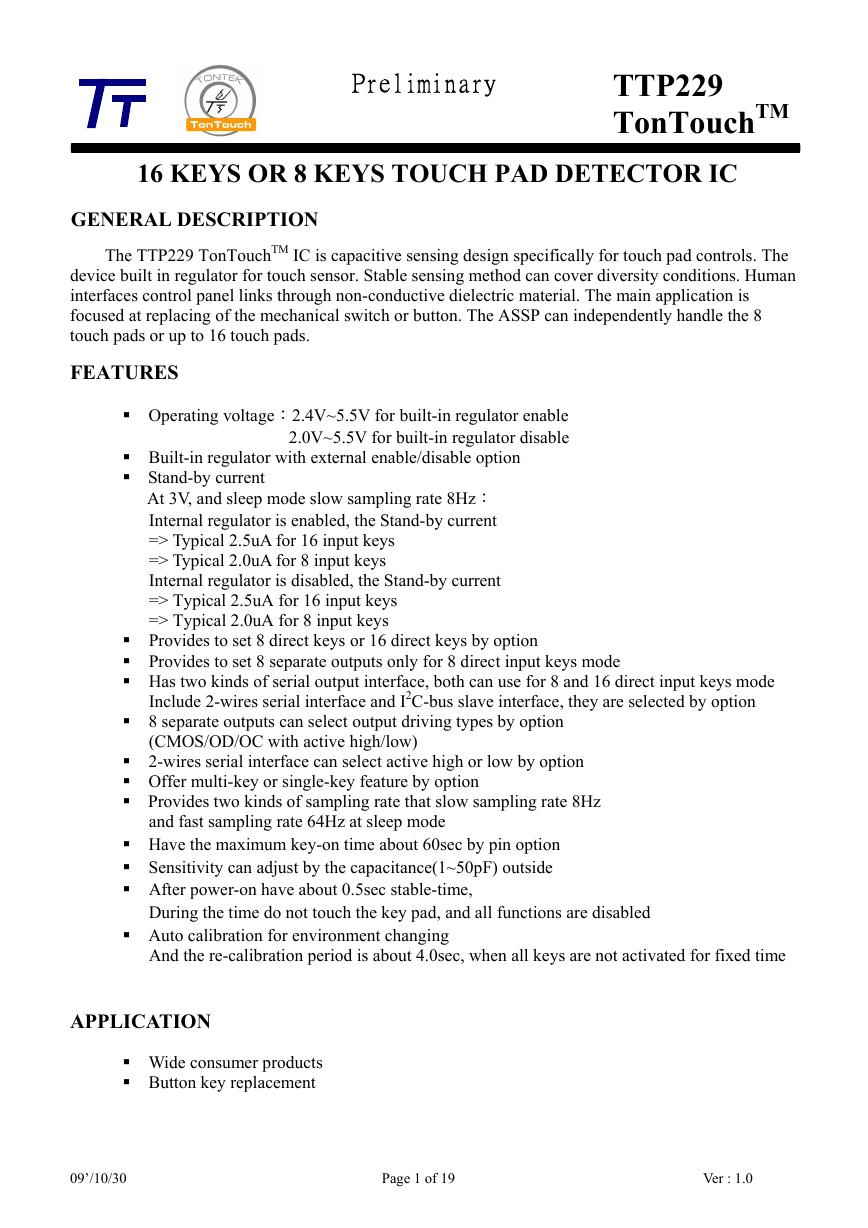
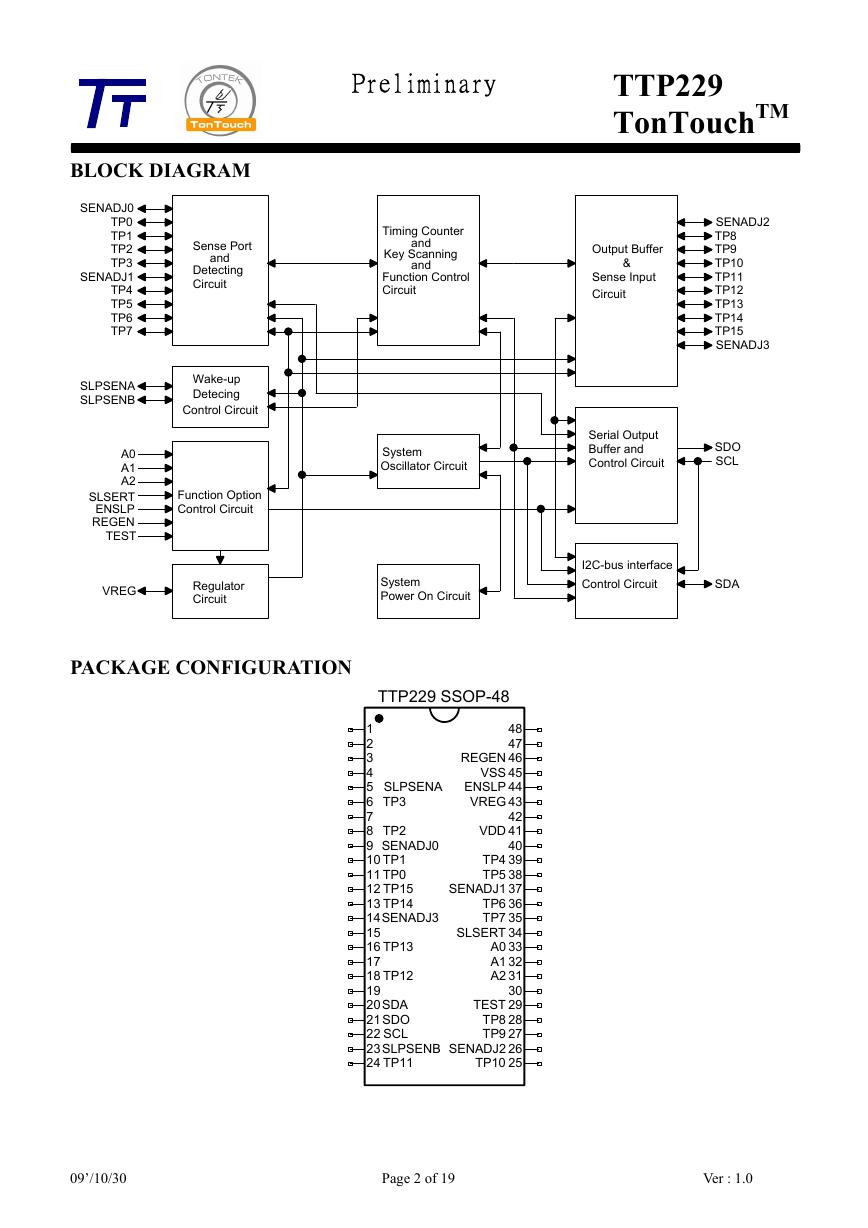
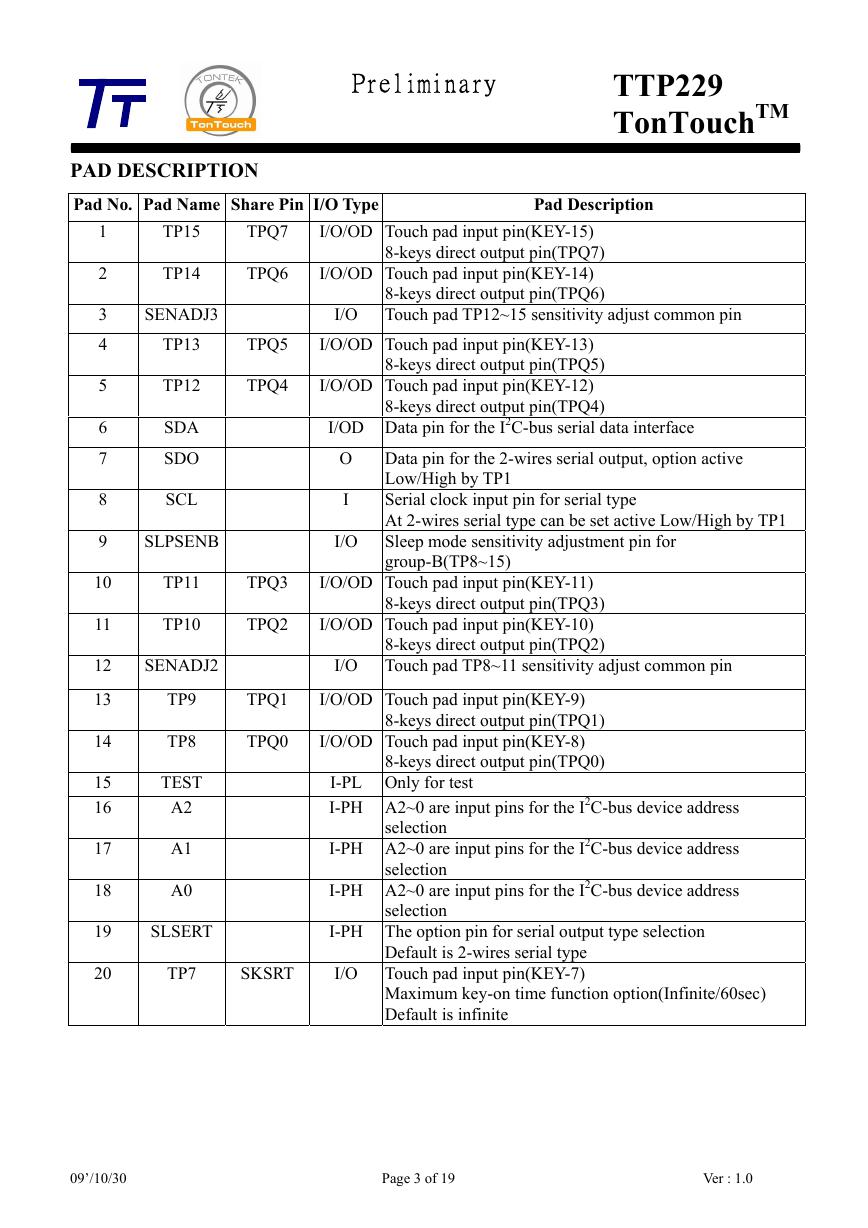

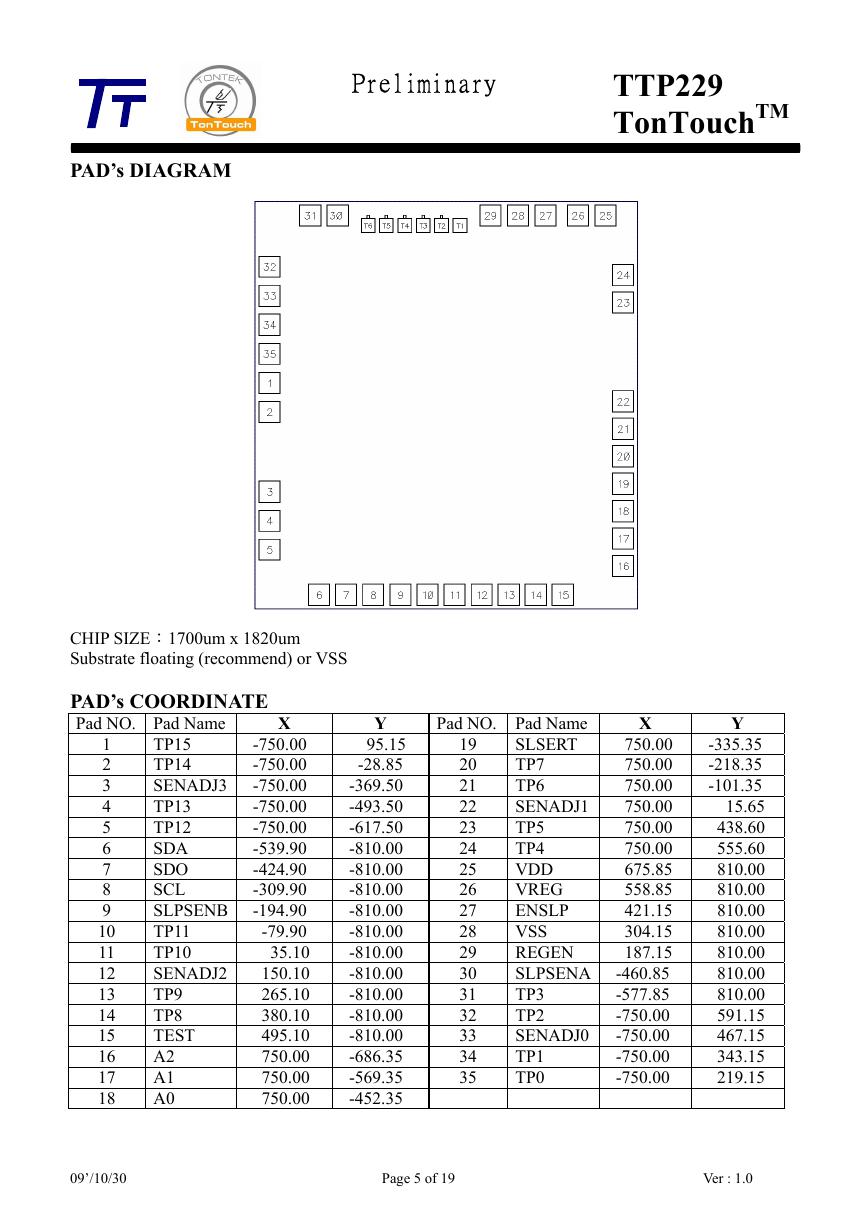
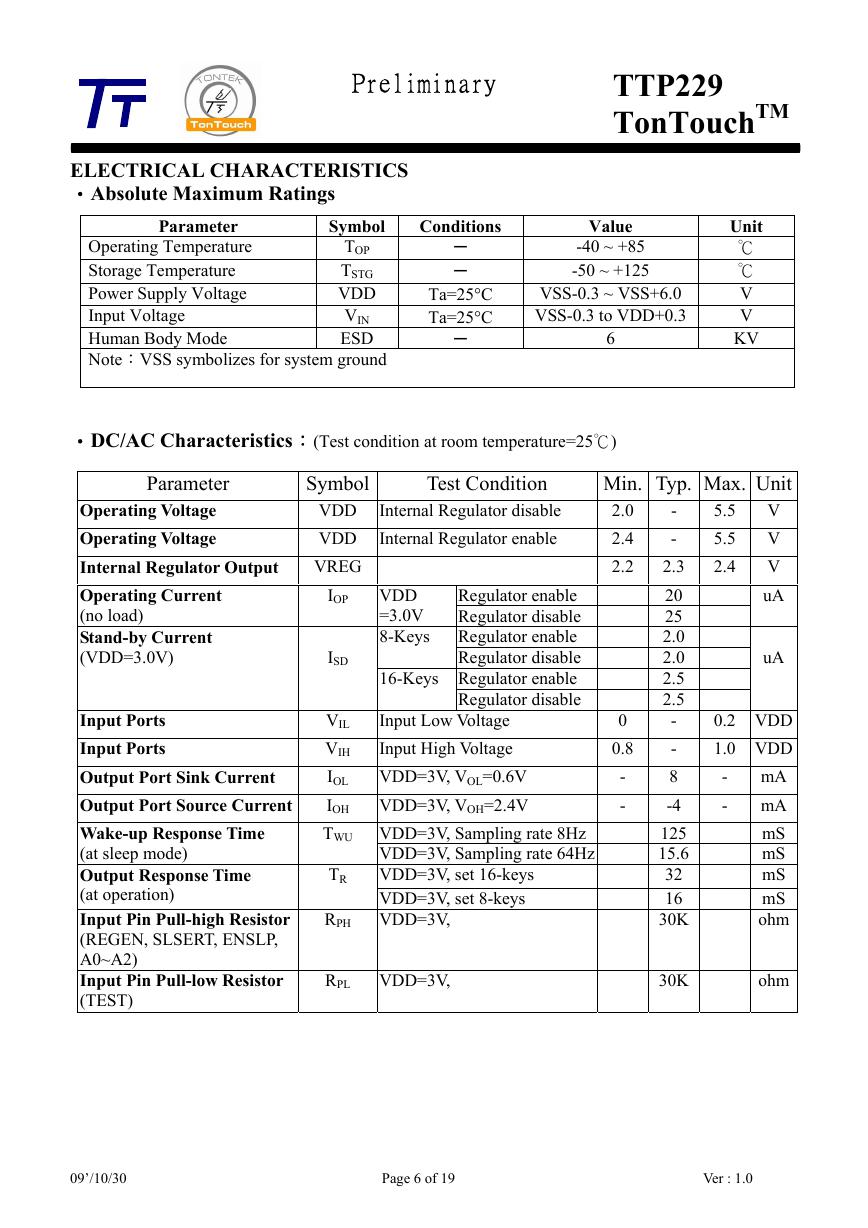
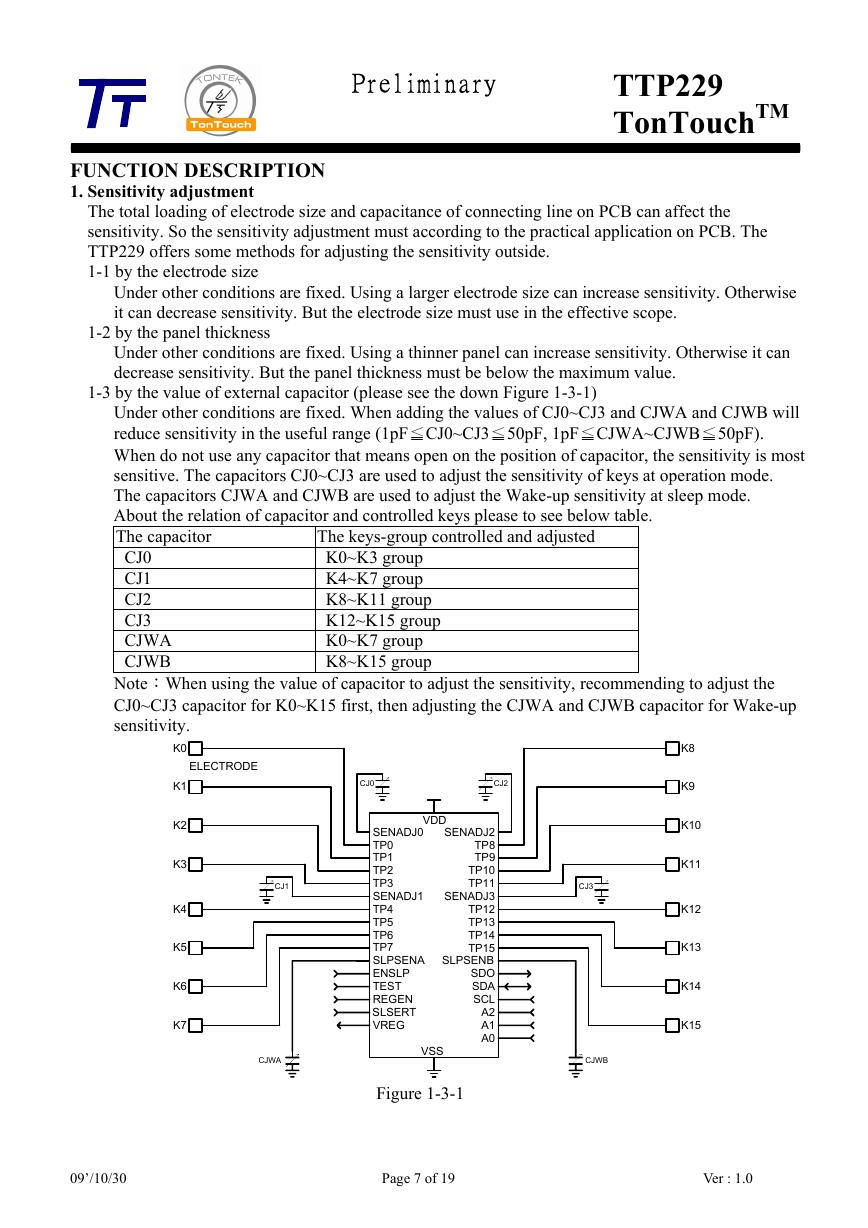
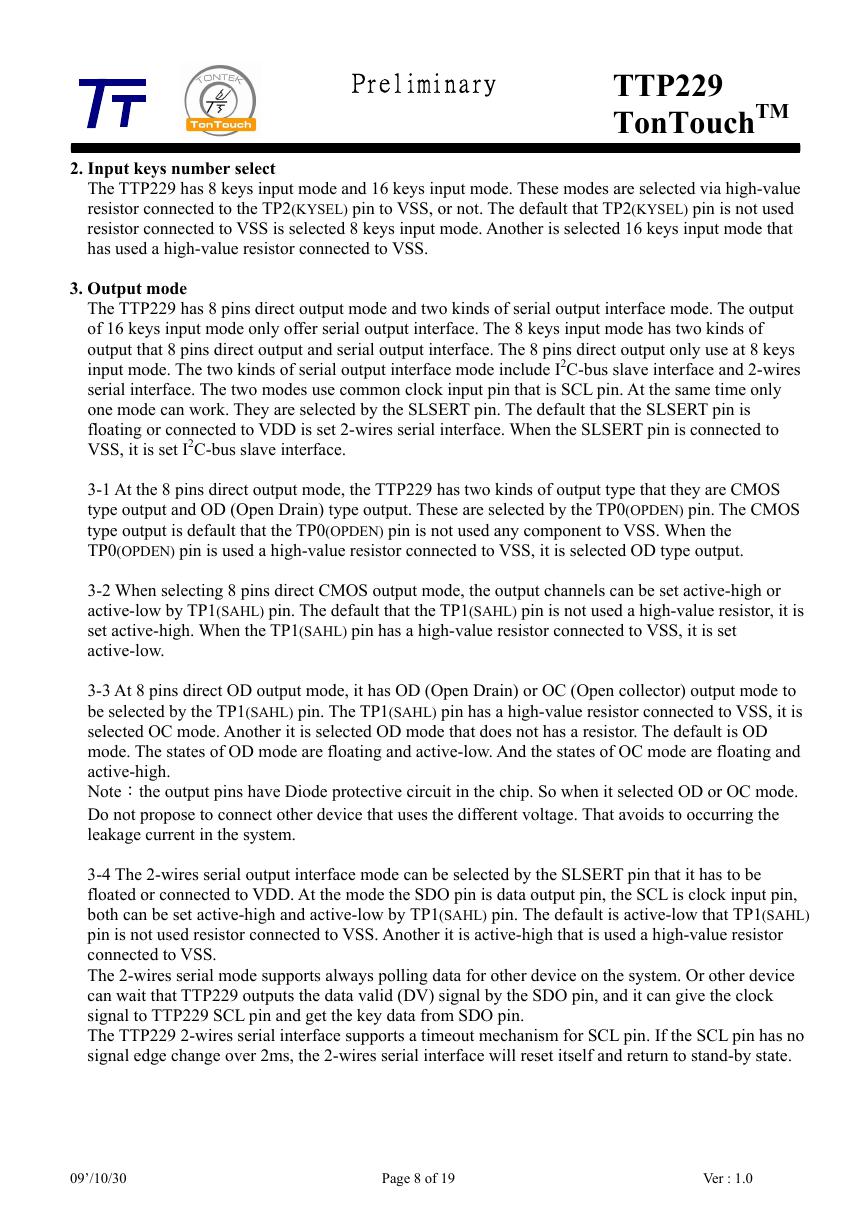








 V2版本原理图(Capacitive-Fingerprint-Reader-Schematic_V2).pdf
V2版本原理图(Capacitive-Fingerprint-Reader-Schematic_V2).pdf 摄像头工作原理.doc
摄像头工作原理.doc VL53L0X简要说明(En.FLVL53L00216).pdf
VL53L0X简要说明(En.FLVL53L00216).pdf 原理图(DVK720-Schematic).pdf
原理图(DVK720-Schematic).pdf 原理图(Pico-Clock-Green-Schdoc).pdf
原理图(Pico-Clock-Green-Schdoc).pdf 原理图(RS485-CAN-HAT-B-schematic).pdf
原理图(RS485-CAN-HAT-B-schematic).pdf File:SIM7500_SIM7600_SIM7800 Series_SSL_Application Note_V2.00.pdf
File:SIM7500_SIM7600_SIM7800 Series_SSL_Application Note_V2.00.pdf ADS1263(Ads1262).pdf
ADS1263(Ads1262).pdf 原理图(Open429Z-D-Schematic).pdf
原理图(Open429Z-D-Schematic).pdf 用户手册(Capacitive_Fingerprint_Reader_User_Manual_CN).pdf
用户手册(Capacitive_Fingerprint_Reader_User_Manual_CN).pdf CY7C68013A(英文版)(CY7C68013A).pdf
CY7C68013A(英文版)(CY7C68013A).pdf TechnicalReference_Dem.pdf
TechnicalReference_Dem.pdf